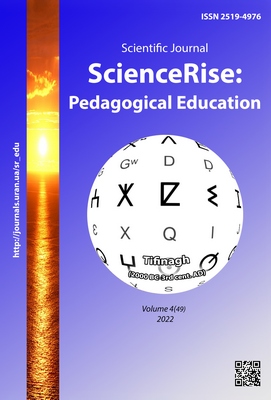Opportunities of a personal learning environment for performing self-education activities of the future pharmacy employee
DOI:
https://doi.org/10.15587/2519-4984.2022.261052Keywords:
personal learning environment, PLE models, ICT capabilities, elf-educational activity, future pharmacy employeeAbstract
The issue of the use of information and communication technologies in the education of pharmaceutical students is highlighted. The author pays special attention to the importance of creating a personal educational environment that enables the student's self-education and is the basis for lifelong education. The author provides a detailed interpretation of the phenomenon, approaches to it, and describes four models that are used in foreign pedagogical practice. The analysis of pedagogical studies made it possible to affirm the opinion about the potential of PLE for the development of the self-educational activity of the student, in particular, the future specialist-pharmacist. The author indicated the directions of using information technologies in medical education. The possibilities of certain elements of the personal educational environment through the prism of their involvement in the educational process, the importance of developing skills and actively using a number of information resources at the same time, systematizing and comparing the acquired knowledge, independently creating new sources of information are described. A number of computer and web technologies have been identified that enable the formation of PLE, promote motivation and development of self-educational activity, namely: the use of structuring of the educational space of higher education institutions based on Ms Office365 and Ms Teams services, MSO365 cloud services; social networks Viber, Facebook and YouTube channels; communication platforms Zoom, Skype, Google Classroom, and others; use of computer modeling of physical, biological, chemical, physiological processes, modeling of laboratory work; use of electronic textbooks; use of multimedia educational and demonstration computer programs, learning and informative video films; development of the department's website for placing organizational and learning information on it; use of computer-based testing of students' knowledge and an interactive survey system. The author provides specific examples from pedagogical practice, proving a direct connection between information and communication technologies that fill PLE with the development of self-education activities of the student
References
- Morin A. (2021). Personalized learning: What you need to know. Understood. Available at: https://www.understood.org/en/articles/personalized-learning-what-you-need-to-know
- ELI 7 Things You Should Know ParentTopics: Teaching and Learning Digital Learning (2009). EDUCAUSE Learning Initiative (ELI) Collection(s). Available at: https://library.educause.edu/-/media/files/library/2009/5/eli7049-pdf.pdf
- Ledeneva, A. V. (2016). Personalnaia obrazovatelnaia sreda v magistrature. Innovatcionnye issledovaniia: problemy vnedreniia rezultatov i napravleniia razvitiia, 3, 27–32. Available at: https://cyberleninka.ru/article/n/kontseptsiya-proektirovaniya-personalnoy-obrazovatelnoy-sredy/viewer
- Dukhnich, Iu. (2011). Personalnaia sreda obucheniia. PLE.
- Harmelen, M. (2009). The Manchester Personal Learning Environment.
- Chatti, M. A. (2010). Personalization in Technology Enhanced Learning: A Social Software Perspective. AahenaUnivercity, 399.
- Michele, M. (2007). Supporting Personal Learning Environments: A Definition of a PLE. Available at: http://michelemartin.typepad.com/thebambooprojectblog/2007/08/supporting-pe-1.html
- FitzGerald, S. (2006). Creating Personal Learning Environment.
- Smolyak, V. (2017). The Content of Readiness of Future Elementary School Teachers for Use of the Personal Learning Environment. Pedahohika formuvannia tvorchoi osobystosti u vyshchii i zahalnoosvitnii shkolakh, 56-57, 496–503. Available at: http://nbuv.gov.ua/UJRN/Pfto_2017_56-57_65
- Buhaichuk, K. L. (2016). Blended learning: theoretical analysis and strategy of implementation in educational process of higher educational institutions. Informatsiini tekhnolohii i zasoby navchannia, 4 (54), 1–18. Available at: http://nbuv.gov.ua/UJRN/ITZN_2016_54_4_3
- Lytvynova S. H. (2016). Teoretyko-metodychni osnovy proektuvannia khmaro oriientovanoho navchalnoho seredovyshcha zahalnoosvitnoho navchalnoho zakladu. Kyiv.
- Morze, N., Spivak, S. (2017). Creating modern cloud-oriented personalized education environment taking into consideration educational process participants' ict competencies. Open educational e-environment of modern university, 3 (2017), 274–282. doi: http://doi.org/10.28925/2414-0325.2017.3.27482
- Fedortsova, O. (2021). Innovative Educational Practices and Their Use in Educational Institutions. New learning technologies, 95 (2021), 213–219. doi: http://doi.org/10.52256/2710-3560.95.2021.24
- Іvankova, N. A., Rizhov, O. A., Androsov, O. І. (2020). Algorithm for the formation of a personal learning environment by means of structuring theeducationalspace of the university based on Office365 and MS Teams services. Open educational e-environment of modern University, 9, 26–40. Available at: https://journals.indexcopernicus.com/api/file/viewByFileId/1180089.pdf
- Slepukhin, A. (2014). Ispolzovanie personalnoi obrazovatelnoi sredy v protcesse individualizatcii smeshannogo obucheniia studentov. Pedagogicheskoe obrazovanie v Rossii, 11, 195–198. Available at: https://cyberleninka.ru/article/n/ispolzovanie-personalnoy-obrazovatelnoysredy-v-protsesse-individualizatsii-smeshannogo-obucheniya-studentov
- Afanasiuk, O. I., Denesiuk, V. I. (2015). Natsionalna stratehiia pobudovy vnutrishnoi medytsyny na period 2015–2025 rr. Problemy ta perspektyvy vyshchoi medychnoi shkoly u rozrobtsi ta realizatsii natsionalnoi stratehii pobudovy novoi systemy okhorony zdorov’ia v Ukraini na period 2015–2025 rr. Vinnytsia, 7–8.
- Heagney M. (2013). What’s a “Clicker”? Teaching with New Technology. Available at: http://www.law.uchicago.edu/alumni/magazine/spring13/clicker
- Shelestova, A. (2021). The electronic education environment development with google classroom tools at the universities. Young Scientist, 4 (92), 240–244. doi: http://doi.org/10.32839/2304-5809/2021-4-92-51
Downloads
Published
How to Cite
Issue
Section
License
Copyright (c) 2022 Kira Hnezdilova, Ruslana Barjadze

This work is licensed under a Creative Commons Attribution 4.0 International License.
Our journal abides by the Creative Commons CC BY copyright rights and permissions for open access journals.
Authors, who are published in this journal, agree to the following conditions:
1. The authors reserve the right to authorship of the work and pass the first publication right of this work to the journal under the terms of a Creative Commons CC BY, which allows others to freely distribute the published research with the obligatory reference to the authors of the original work and the first publication of the work in this journal.
2. The authors have the right to conclude separate supplement agreements that relate to non-exclusive work distribution in the form in which it has been published by the journal (for example, to upload the work to the online storage of the journal or publish it as part of a monograph), provided that the reference to the first publication of the work in this journal is included.








